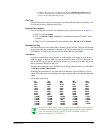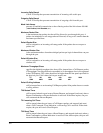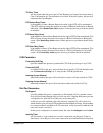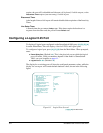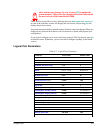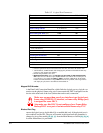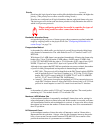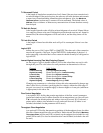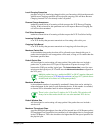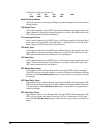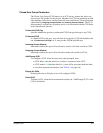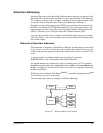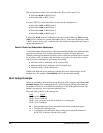
Configuring X.25 8-15
Priority
prioritizes this logical port for intra-nodal traffic; the higher the number, the higher the
priority. (This priority has no effect on traffic exiting a node.)
Priorities are configured on all logical interfaces that use a physical frame relay port.
The device processor in the node uses these priorities to help determine the order in
which it will process protocols.
When configuring priorities, be careful to consider the types of
traffic being routed on other connections in the node.
Bandwidth Allocation Group
assigns the logical port to one of sixteen groups whose parameters regulate bandwidth
usage by outgoing traffic on the physical link. See "Configuring Bandwidth Allo-
cation Groups" on page 7-6.
Encapsulation Method
is the method by which traffic over the logical port will be enveloped within frame
relay frames for transmission. The valid methods are T1.617 Annex G and T1.617
RFC1490.
With Annex G, a LAPB frame is encapsulated immediately following the frame relay
header (flag, 2-byte T1.618 header, LAPB address, LAPB control, LAPB I-field
[x.25/x.75]). With RFC1490, the order is: T1.618 header, Q.922 control byte, Q.933
NLPID, 2-byte level-2 protocol ID, 2-byte level-3 protocol ID, LAPB frame.
Although it may appear that RFC1490 encapsulation uses more overhead, the number
of protocols being encapsulated are important in determining the method:
●
RFC1490 – The protocols will be identified on the DLCI based on their NLPIDs
and (if applicable) level-2 and level-3 headers (e.g., X.25: flag, T1.618 2-byte
header, 0x03 Q.922 control, 0x08 Q.933 NLPID, T1.617 level-2 LAPB PID
0x51 81, T1.617 level-3 PID 0x67 80, LAPB frame).
●
Annex G – Each protocol must be encapsulated in X.25 for transmission over a
single DLCI, because Annex G allows the DLCI to be used only by X.25. Each
protocol in would require its own X.25 virtual circuit and level-3 windows.
Modulo
is the number of values used in X.25 level-2 sequenced packets. The actual packet
numbering is 0–7 for modulo 8 and 0–127 for modulo 128.
Maximum LAPB Window Size
is the maximum number of sequentially numbered I-frames that can be waiting for
acknowledgment by the next station in the path. If this number is exceeded, no frames
will be transmitted until an acknowledgment is received. A larger value allows faster
throughput, but increases the number of frames that may have to be retransmitted if
there is a problem.
N2 Retransmit Count
is the maximum number of times the node will attempt to send an I-frame after a
Retransmit Period expiration. A larger value for this parameter increases the proba-
bility of an eventual correct transfer between DTE and DCE, but a smaller value
permits faster detection of a permanent error condition.
(continued)



